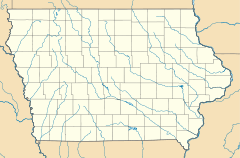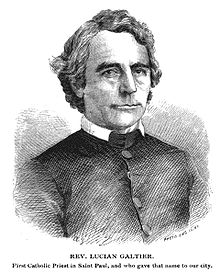- Church of All Saints (Keokuk, Iowa)
-
St. Peter Church

Location: 301 S. 9th Street, Keokuk, Iowa Coordinates: 40°23′50″N 91°23′25″W / 40.39722°N 91.39028°WCoordinates: 40°23′50″N 91°23′25″W / 40.39722°N 91.39028°W Built: 1879-1885 Architect: William John Dillenburg, Joseph Conradi Architectural style: Late Gothic Revival Governing body: Private NRHP Reference#: 83000384[1] Added to NRHP: July 14, 1983 The Church of All Saints is a parish of the Roman Catholic Diocese of Davenport. The church is located in Keokuk, Iowa, United States, at 301 S. 9th Street. The church building is listed on the National Register of Historic Places as St. Peter Church, the name of the original congregation.
Contents
History
The area of Keokuk was within the Half-Breed Tract. It was land set aside by the United States Senate on January 18, 1825 for settlement of mixed-race descendants of the Sac and Fox tribes. Over the years, some of the women had married French trappers who worked the area, and the descendants were excluded from communal lands because their fathers lacked tribal status. Mixed-race families could live in the Half-Breed Tract but could not sell individual allotments until Congress changed the law in 1837.[2]
In 1824 Bishop Louis Dubourg of New Orleans appointed the Rev. Charles Felix Van Quickenborne, SJ the Vicar General of Upper Louisiana, which included the Half-Breed Tract. He is the first priest known to have visited the area of present-day Keokuk, visiting in 1832 and 1833, after that section of Iowa was opened to settlement. He recommended a church be built, as he thought the funds could be easily raised. The next priest to visit the area was the Rev. Peter Paul Lefevere. He reported that the number of Catholics in the area numbered 38.[3] In 1840 the Rev. Samuel Charles Mazzuchelli, OP from St. Paul’s Church in Burlington added Keokuk to his missionary area. The same year the Rev. John George Alleman started visiting Keokuk regularly from St. Joseph’s in Fort Madison; however, he was unable to raise enough money to build a church.[2] He would continue visiting the area until 1848.
The first parish established in the town was named St. John the Evangelist and was founded in 1844 by Rev. Lucien Galtier, who was named the first pastor in Keokuk. The church was a log structure built on the corner of Second and Blondeau Streets. The church was built by Hugh V. Gildea from Dubuque with the help of Father Galtier. A future historian of Keokuk, Virginia Wilcox Ivins, remembered seeing the "elegant" priest hammering on the church roof on a hot July day when she was twelve years old. It measured 20 by 30 feet and was 12 feet high. It cost $598.37, and was paid for from funds received from the Society of the Propagation of the Faith.[3] Galtier stayed only a few months, and Father Alleman had care of the Keokuk parish again. The Rev. Jean Villars became its pastor in 1848 and he stayed for nine years. The Rev. William Emonds was sent to Keokuk in 1855 to buy back property lost by the church. Instead he bought new property on which St. Peter’s Church was founded. By now there were quite a few German Catholics in Keokuk, who had immigrated after the 1848 Revolutions, and they wanted a priest who spoke their language. After 1857 St. Peter's became the only Catholic church in Keokuk. St. John the Evangelist was abandoned and Father Villars recalled. The cornerstone was laid for the original church on Exchange Street between 9th and 10th Streets on April 20, 1856.
St. Mary’s Church was established in 1867 to serve the pastoral needs of German immigrants. The parish built a red brick church north of St. Peter’s in 1911. St. Francis de Sales Church was begun in 1870 to serve the neighborhoods on the east side of town. All three parishes became part of the Davenport Diocese when it was established in 1881. St. Francis parish built a stone church in 1899, designed by J.J. Egan who had earlier designed both Sacred Heart Cathedral in Davenport and St. Ambrose Cathedral in Des Moines.[3]
As St. Peter's grew, in 1872 the parish decided to relocate the church. Three lots were purchased at 9th and Bank Streets. Plans for the new church building were completed in 1878 by Chicago architect Johann Dillenburg, who had been as assistant architect in completing the Cologne Cathedral in Germany. Ground was broken for the new structure in 1879, and it was dedicated on September 27, 1885.[4][dead link]
The church’s stained glass windows were created by the A. Misch Company in 1884 at a cost of $3,300.[4] The Stations of the Cross came from Munich, Germany and were erected on February 28, 1892. The commission for the church’s solid marble altar was given to Joseph Conradi of St. Louis, Missouri in 1904. The building’s foundations had to be reinforced to support the weight of the new altar. The baptistery was added to the sacristy area at the same time. The altar was dedicated on October 8, 1905.[4]
In 1886 Franciscan Sisters from Peoria, Illinois opened St. Joseph Hospital next to St. Mary’s Church. In 1975 it merged with Graham Hospital and became Keokuk Area Hospital.[3]
Because of declining numbers of clergy in the diocese, and the declining population in Keokuk, the diocese decided to consolidate the three parishes into one. The Church of All Saints was established in 1982. It was at this time that the Chapel of the Angels was added in the left sacristy area of the church. The chapel used the angel statues that flanked the high altar at St. Mary’s, the pews from St. Francis de Sales, as well as other elements from the three churches. The Blessed Sacrament is housed in the chapel, and it is used for weekday Masses and First Friday Adoration. The organ from St. Mary's was placed in the main church.
A Monument Garden is located near the Chapel entrance behind the rectory. The cornerstones from the first St. Peter's Church (1856), the second St. Mary's Church (1911), the second St. Francis de Sales Church (1898), and St. Mary's School (1907) were refaced to designate All Saints parish.[4]
Catholic schools
The first Catholic school was established in Keokuk by the Visitation Sisters in 1852. They opened a free school first. In 1853 they started a new convent and a select school for both boarders and day students. St. Peter’s Parish desired a parochial school, but the Visitation Sisters' rule forbade them from teaching in parochial schools.[3] The school was started by 1859, and the Rev. Louis DeCailly asked the School Sisters of Notre Dame to teach in the school. They taught there from 1861-1864. They withdrew from teaching when Father DeCailly wanted to start a high school for girls, and the Notre Dame Sisters felt it would infringe on the Visitation Academy.
Lay teachers took over the teaching responsibilities in the parish school. The Visitation Sisters left in 1867 because of financial problems that resulted from the building of a new school. The parish took over the school and the Daughters of Charity came to teach the same year. The common school and the select school were merged in 1877. The grade school was renamed St. Vincent’s. The Notre Dame Sisters came back to Keokuk and staffed the parochial school at St. Mary’s Church. St. Peter’s High School continued until a central Catholic high school named Cardinal Stritch was opened in 1965. The Daughters of Charity left Keokuk in 1996. St. Vincent’s moved into the Cardinal Stritch building after it closed in the early 21st century.
References
- ^ "National Register Information System". National Register of Historic Places. National Park Service. 2009-03-13. http://nrhp.focus.nps.gov/natreg/docs/All_Data.html.
- ^ a b Griffith, C. F.. "Our First Catholics: Rat Row, Half-Breed Tract, French Traders". iagenweb.org. http://iagenweb.org/lee/Church/StPeters/stpeter-1.htm. Retrieved 2010-07-03.
- ^ a b c d e Schmidt, Madeleine M. (1981). Seasons of Growth: History of the Diocese of Davenport. Davenport, Iowa: Diocese of Davenport.
- ^ a b c d "About", Keokuk All Saints Church Website
External links
U.S. National Register of Historic Places Topics Lists by states Alabama • Alaska • Arizona • Arkansas • California • Colorado • Connecticut • Delaware • Florida • Georgia • Hawaii • Idaho • Illinois • Indiana • Iowa • Kansas • Kentucky • Louisiana • Maine • Maryland • Massachusetts • Michigan • Minnesota • Mississippi • Missouri • Montana • Nebraska • Nevada • New Hampshire • New Jersey • New Mexico • New York • North Carolina • North Dakota • Ohio • Oklahoma • Oregon • Pennsylvania • Rhode Island • South Carolina • South Dakota • Tennessee • Texas • Utah • Vermont • Virginia • Washington • West Virginia • Wisconsin • WyomingLists by territories Lists by associated states Other  Category:National Register of Historic Places •
Category:National Register of Historic Places •  Portal:National Register of Historic Places
Portal:National Register of Historic PlacesRoman Catholic Ecclesiastical Province of Dubuque Dioceses Cathedrals St. Raphael’s Cathedral, Dubuque • Sacred Heart Cathedral, Davenport • St. Ambrose Cathedral, Des Moines • Cathedral of the Epiphany, Sioux CityBasilicas Colleges Denmark Bridgeport Bridge • Denmark Congregational Church
Donnellson John McGreer Barn and CribFarmington Sharon Cemetery Historic DistrictFort Madison Albright House • Atchison, Topeka and Santa Fe Passenger and Freight Complex Historic District • Chief Justice Joseph M. Beck House • Cattermole Memorial Library • Faeth Farmstead and Orchard District • Fort Madison Bridge • Fort Madison Downtown Commercial Historic District • Iowa State Penitentiary Cellhouses Historic District • Lee County Courthouse • Daniel McConn Barn • Moyce-Steffens House • Old Fort Madison Site • St. Mary of the Assumption Church • George E. Schlapp House • Craig and Virginia Sheaffer House • Walter A. Sheaffer HouseFranklin Christian and Katharina Herschler House, Barn, and Outbuildings Historic DistrictKeokuk Gen. William Worth Belknap House • Gen. Samuel R. Curtis House • GEO. M. VERITY • E. H. Harrison House • Hotel Iowa • John N. and Mary L. (Rankin) Irwin House • C. R. Joy House • Keokuk National Cemetery • Keokuk Young Women's Christian Association Building • Lock and Dam No. 19 Historic District • Justice Samuel Freeman Miller House • St. John's Episcopal Church and Parish Hall • St. Peter Church • Hugh W. and Sarah Sample House • The Park Place-Grand Avenue Residential District • U.S. Post Office and Courthouse • Alois and Annie Weber House • Frank J. Weess HouseMontrose St. Barnabas Episcopal ChurchPrimrose Primrose MillCategories:- Religious buildings completed in 1885
- 19th-century Roman Catholic church buildings
- Roman Catholic Diocese of Davenport
- Roman Catholic churches in Iowa
- Churches in Lee County, Iowa
- Properties of religious function on the National Register of Historic Places in Iowa
- Gothic Revival architecture in Iowa
- Religious organizations established in 1982
Wikimedia Foundation. 2010.







